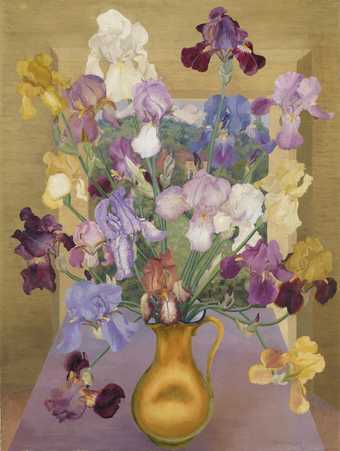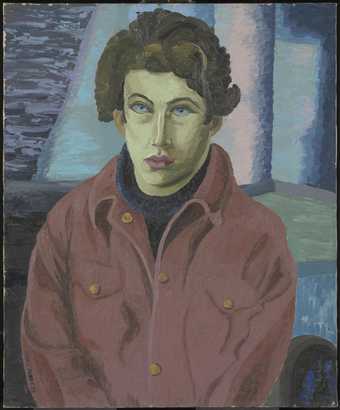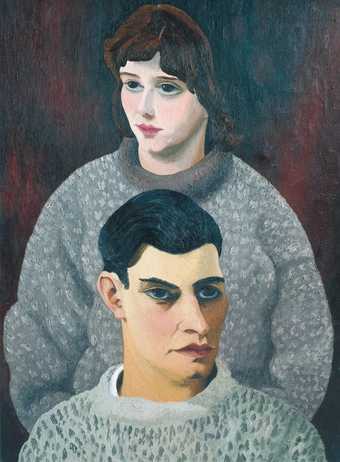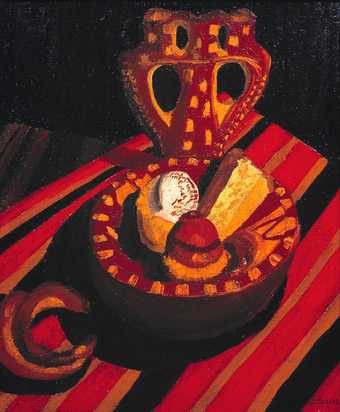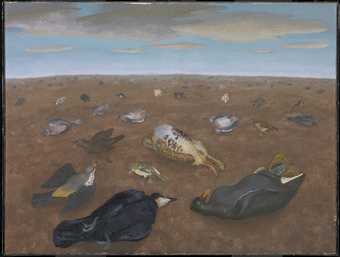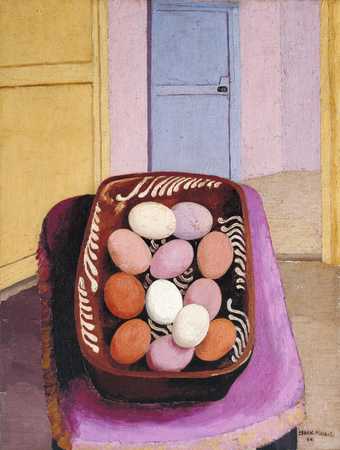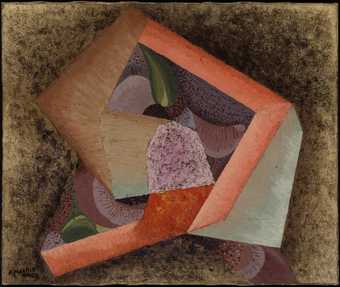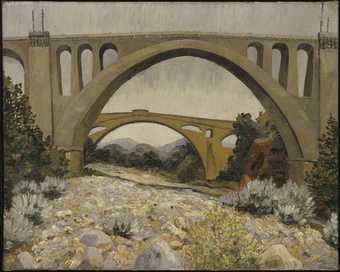
Not on display
- Artist
- Sir Cedric Morris, Bt 1889–1982
- Medium
- Oil paint on canvas
- Dimensions
- Support: 620 × 700 mm
- Collection
- Tate
- Acquisition
- Bequeathed by Miss Nancy Morris, the artist's sister 1988
- Reference
- T05498
Summary
Not only did Cedric Morris paint birds, he bred them. His knowledge and understanding of these creatures may have contributed to his ability to re-create in paint, 'living, breathing, flying birds, not coloured reproductions of stuffed carcases', as one reviewer wrote of his exhibition at Arthur Tooth and Sons, London, in May 1928 (quoted in Morphet, p.32).
In his analysis of Morris's paintings, Richard Morphet suggests that the 'unusual force of Cedric's paintings derives from the projection of the subject through a dynamic economy in combination with an acute sense of pictorial realism' (Morphet, p.82). In Peregrine Falcons, Morris does not attempt to record the exact physical detail of the birds or their surroundings. Instead he presents them in a slightly formalised and simplified manner, the intention of which is, in his own words, to 'provoke a lively sympathy with the mood of the birds which ornithological exactitude may tend to destroy' (quoted in Morphet, p.86).
This lively sympathy is further enhanced by animating the paint's surface. As early as 1922 Morris's use of texture had been noted by at least one reviewer, who wrote, 'the light dances among the waves of paint, flickering brightly, so the whole work takes on the appearance of a mosaic, tapestry or precious enamel' (quoted in Morphet, p.29). In Peregrine Falcons the use of a spiky impasto for the birds and background enlivens them and gives them an actual physical presence.
The composition of the painting and Morris's use of colour forcefully underscore the falcons's status as the subjects of the picture. There is a dramatic divide in the background between the rocks surrounding the bird on the left and the distant sky framing the one on the right. The move from shallow spatial depth on the left to extremely deep perspective on the right maintains the visual interest in both halves and pushes each bird forward. Likewise, the warm colours of their plumage and talons advance against the receding cool tones of the background.
In the lower left, next to the four eggs, is a duck's skull. Its inclusion is a reminder of the predatory nature of these birds, and is typical of Morris's unsentimental understanding of the animal kingdom and its cycle of life.
In an article titled 'A Left-to-Right Painter', published in the Evening Standard, 9 May 1928, the critic R H Wilenski revealed that Morris painted his pictures from the top left corner without any preparatory drawing on the canvas, proceeding inch by inch until he reached the bottom right corner. Although such a method might seem incompatible with Morris's statement in 1924 that 'all my pictures are painted from the original in the open air' (quoted in Morphet, p.91), there is no underdrawing visible in Peregrine Falcons. This suggests that either Morris changed his practice after 1924 or, as Morphet believes, that neither method was exclusively followed. It is not known where the picture was painted, though it is likely that it was at Benton End, near Hadleigh, Suffolk, to where he and Arthur Lett-Haines had moved The East Anglian School of Painting and Drawing in 1940.
Further reading:
Richard Morphet, Cedric Morris, exhibition catalogue, Tate Gallery, London 1984
Toby Treves
November 2000
Does this text contain inaccurate information or language that you feel we should improve or change? We would like to hear from you.
Technique and condition
Painted on a re-used canvas which was primed and partly painted on what is now the reverse before being restretched and primed by the artist with a white oil ground.
The artist has painted thickly in oil using a stiff brush to create a spiky impasto over most of the surface. This follows closely the forms of the falcons and background. The technique is wet-in-wet paint and in the main opaque, except for local areas of glazing in the shadows. Small patches of ground are visible at the boundaries of some forms indicating that the image was built up in dabs. No underdrawing is visible. Sand or some other coarse powder has been added to the paint used for the rocks to create a textured surface.
The work has never been varnished. The painting has suffered from being left in damp and dirty conditions but after cleaning is now in reasonably good condition. Some drying cracks are evident on the falcon.
The original frame is stamped Morris.
Stephen Hackney
1995
Explore
You might like
-
Sir Cedric Morris, Bt Iris Seedlings
1943 -
Sir Cedric Morris, Bt Lucian Freud
1941 -
Sir Cedric Morris, Bt David and Barbara Carr
c.1940 -
Sir Cedric Morris, Bt Patisseries and a Croissant
c.1922 -
Sir Cedric Morris, Bt Landscape of Shame
c.1960 -
Sir Cedric Morris, Bt Belle of Bloomsbury
1948 -
Sir Cedric Morris, Bt The Eggs
1944 -
Sir Cedric Morris, Bt Experiment in Textures
1923 -
Sir Cedric Morris, Bt Les Ponts de Ceret
1923

